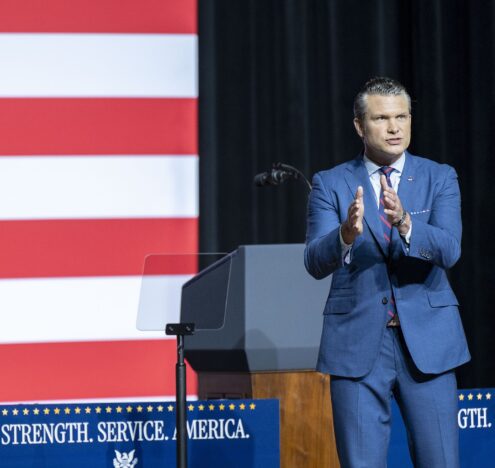Editor’s Note: In the wake of a historic second impeachment, we’ve been thinking a lot about broader presidential authorities. This piece is the second of two that examine the president’s authority to use nuclear weapons. The first is here.
Following President Trump’s election, there was extensive media coverage and other commentary about the danger of a mercurial president with his “finger on the button.” It was then that many people first learned that US policy gives the president the sole authority to order the use of nuclear weapons. The recent attack on Congress that the president himself encouraged brought this issue to the fore again and many people — including Nancy Pelosi, the Speaker of the House — expressed concern that Trump might order a nuclear attack in his final weeks in office.
Now that it is President Biden who has the sole authority to order a nuclear strike, concern about this policy has undoubtedly abated, but it shouldn’t.
What does the president’s sole authority mean in practice?
The impetus for this arrangement is to ensure that these weapons remain under civilian control by requiring the military to get the president’s explicit approval for their use — which is important and a good thing.
Also on the positive side, as Mr. Shugart discusses here, the Defense Department takes seriously the Law of Armed Conflict and would only use nuclear weapons if it judged their use to be legal. This adherence to the laws of war is what would stop the Pentagon from simply carrying out a launch order from the president.
Now that it is President Biden who has the sole authority to order a nuclear strike, concern about this policy has undoubtedly abated, but it shouldn’t.
All the pre-planned nuclear attack options laid out in the book the president’s aide carries are nominally legal — but only under specified circumstances. In other words, if Russia launches a certain attack on the United States, some — but not all — of the options would be legal.
In all cases involving the use of nuclear weapons, the National Military Command Center would provide secure communications between the president, secretary of defense, combatant commanders and others. The Center is overseen by the Chairman of the Joint Chiefs of Staff and staffed at all times by five rotating teams of some two dozen military personnel, each headed by one of the Deputy Directors for Operations. One of these people would physically transmit the launch order, but they would not be operating in isolation.
There are three basic scenarios under which the president would order the use of nuclear weapons.
The first case is one in which the decision to use nuclear weapons — either first or in response to a nuclear attack — originates with the Pentagon. The most time-constrained case would be a Pentagon decision to launch the ICBMs in response to warning of a Russian attack. Because long-range missiles take about 25 minutes to travel between the United States and Russia, the president would have some 10 minutes to discuss the Pentagon’s attack options and approve a launch order. Since it is the Command Center that would operate the secure communication line with the president and others, the staff would be well aware of the pending order. Once the president gives the order and provides the authentication code proving they are the president, someone would encode and distribute the order to the launch crews — and off the missiles would go.
The second case is one in which the decision to use nuclear weapons originates with the president, who consults with the secretary of defense and other military leaders. (This would by necessity be a first-use of nuclear weapons; any retaliatory use would be initiated by the Pentagon, since only it would know of an incoming nuclear attack.) These leaders would work with the president to identify legal nuclear attack options, if any exist, and presumably legal non-nuclear options as well.
As Gen. John Hyten, then Commander of US Strategic Command, explained in November 2017, “I provide advice to the President. He’ll tell me what to do, and if it’s illegal, guess what’s going to happen? I’m gonna say, ‘Mr. President, that’s illegal.’ Guess what he’s going to do? He’s going to say, ‘What would be legal?’ And we’ll come up with options of a mix of capabilities to respond to whatever the situation is, and that’s the way it works. It’s not that complicated.”
As in the first case, officials in the Command Center would know that an order was pending and that senior military leaders had judged the order to be legal.
It is the third case that has led to widespread concern. This is the case in which the decision to use nuclear weapons originates with the president, who consults with no one but instead calls the Command Center directly. This would be an extraordinary situation and clearly distinct from the other cases discussed above, in which the Command Center personnel would be fully aware of an impending order. Simply authenticating and transmitting the president’s order to the launch crews may be protocol for a launch order that the staff is aware is pending and that senior military leaders have sought or at least approved, and have determined to be legal. But it seems inconceivable that the same protocol would apply to a presidential order-from-the-blue.
At a minimum, military leaders would want to know that the United States was about to launch a nuclear attack — which would have profound security implications. The only plausible protocol for how to respond to an order-from-the-blue is that the commanding officer of the Command Center would immediately inform their boss, who would inform their boss — the Chair of the Joint Chiefs. In a short matter of time, the secretary of defense and other military leaders would be in secure communication with each other — and presumably with the president, who would have to be told that his or her launch order would not be carried out unless and until it was determined to be legal.
In any event, since this launch order would be for the first use of weapons, there would be time for military leaders to assess its legality as well as discuss alternatives with the president.
We are left with some good and bad news about current US policy. The good news is that the Pentagon would not simply execute an out-of-the blue nuclear launch order from the president without first determining that the attack would be legal. The bad news is that a legal attack — whether it originated with the Pentagon or the president — could still be unwise, and the authority to order a legal attack still rests with one person. The Pentagon should instead be required to obtain the consent of additional designated officials before it would carry out a legal launch order from the president. The good news is that there is a straightforward and expeditious way for the Pentagon to do so. President Biden should adopt this approach and limit his own authority to order the use of nuclear weapons, thereby setting a new standard for future presidents.
Lisbeth Gronlund and David Wright are Research Affiliates in the Laboratory for Nuclear Security and Policy in MIT’s Department of Nuclear Science and Engineering. They co-directed the Global Security Program at the Union of Concerned Scientists from 2002-2020.




















